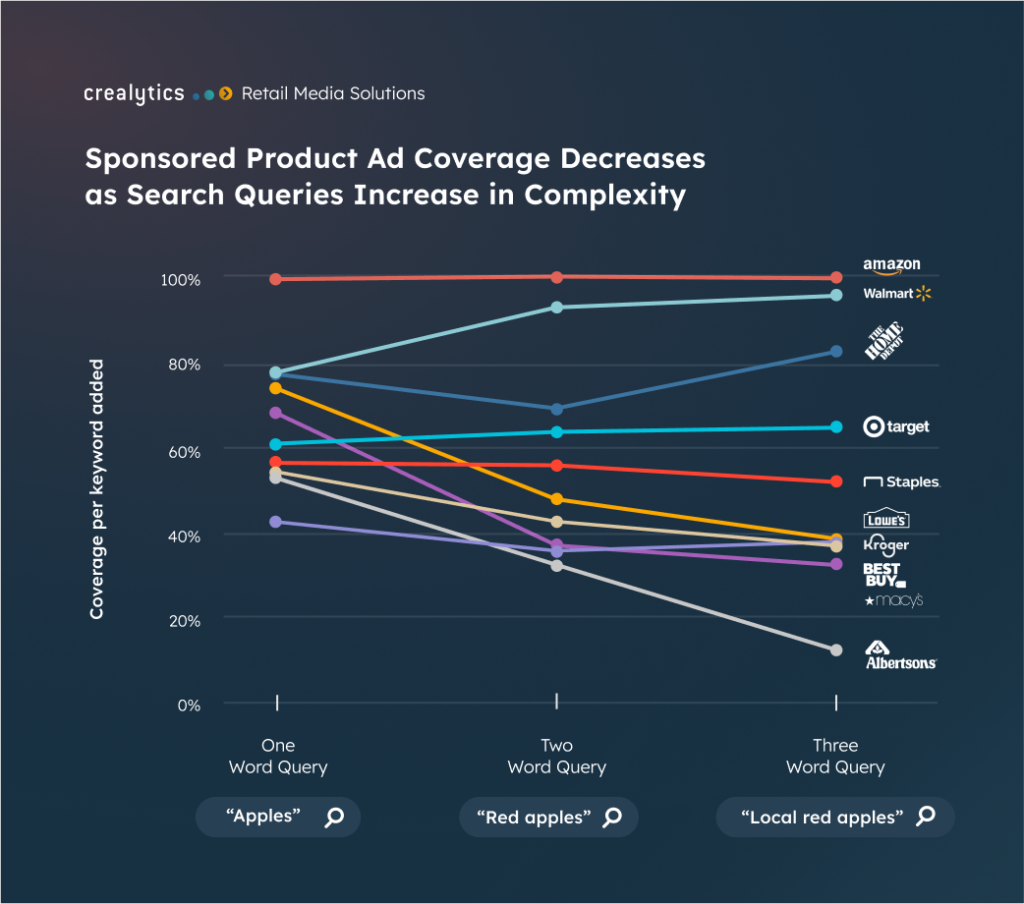Retail Media Networks (RMNs) who don’t cover multiple word searches are leaving money on the table.
For half of the 10 U.S. Retail Media Networks included in our Sponsored Products Benchmark Report (2023), sponsored product ad coverage decreases as search queries increase in number of words.
Below we see, as search queries increase from two to three words, ad coverage decreases for Lowes, Kroger, Best Buy, Macy’s and Albertsons.

In particular, Albertsons loses 50% coverage per extra word in the search query. This means that sponsored product placements for long-tail search terms are not getting filled.
Interestingly, Walmart’s results indicate that they may have more single-word search queries that are not receiving adequate coverage.
Like we see in the example above, RMNs who aren’t seeing a drop in ad coverage with increased search query complexity–Walmart, Amazon and Staples –are leveraging a more sophisticated approach to sourcing relevant sponsored products.
Some RMNs are handling multi-word search queries better than others. Why?
Our Head of Product Mark Burton weighs in:
“Using keywords has been a very common targeting method for sponsored ads, but the approach has its limitations.
When keywords are the only consideration, there can be a long tail of search terms which don’t yield ads, especially as the search becomes more complex and specific.
At the same time, advertisers may have to maintain lists of hundreds or thousands of exact search terms to guarantee coverage or rely on broad matching approaches which quickly lose relevancy.
We see some evidence in the dataset here of coverage limitations among the retail media networks we included. We also see examples of retailers who are moving beyond just keywords and incorporating more advanced approaches, such as relevancy, to place ads.
These retailers can expect to see better coverage of more relevant sponsored products, and that in turn should generate more yield and revenue and sales.”

Why is it important for retail media networks to go beyond keywords to serve more relevant sponsored products?
We asked a few industry contacts to weigh in on why it’s important for RMNs to go beyond keywords to determine sponsored product relevancy. Here’s what they shared.
“Relevance should incorporate both literal keywords AND consumer intent and context indicators.”
“It’s important that retail media networks work with CX and eCommerce partners to align on an understanding of contemporary customer expectations and behavior.
In particular, the definition of relevance should incorporate both literal interpretations of keywords AND inferential, AI-based, interpretations of a consumer’s intent and context.
Relevance shouldn’t be overly restrictive any more so than it should be overly broad to serve customers. That understanding will help find the Goldilocks zone that optimizes CX, merchandising, and media objectives. The reality is that all three are important to the flywheel.
That also impacts ad supply. It’s worth remembering that both the digital shelf and, by extension, sponsored products ad inventory are finite.
That’s true from customer, retailer, and ad supplier standpoints. Retailers operating a scaled RMN need to have an always-on supply-side strategy that is attentive to everything from CX to their RMN P&L and everything in between.”

RMNs need to cater to all different types of searches
On the advertiser side, Sebastian Bardin, Former Head of Ecommerce Marketing at Unilever explained why brands need their retail media networks to cater to search queries with more keywords.
“For some of our products, we have so many variants/format/ sizes- we need our retail media networks to cater to all of those different searches.
For example, with brand investing more and more into sustainability, keyword search capabilities need to reflect them too, i.e. Persil capsule plastic-free box or Biodegradable multipurpose cleaning wipes.”

Parting Thoughts
Paul Dahill, VP of Sales at Crealytics shares why it’s an urgent priority to optimize sponsored product delivery:
“Sponsored search is the best performing ad inventory that a retailer has. Logically, you want to apply the smartest possible approach to make the most of this high-value inventory.
But here’s the thing—as Keith alluded to above–there are only so many searches to monetize and if retail media networks are limited to a direct match keyword approach, they are likely missing revenue opportunities.
Imagine a department store retailer. They may field 3,000 searches a day for denim. Out of these…perhaps 500 queries only contain one word: denim. If they are using a direct match approach to keywords…they may be missing out on showing sponsored products for 1/6th of those queries…which is leaving money on the table.
Leaving the success of your sponsored search business in the hands of a buyer who might only be using very simplistic keywords is a miss. Mature retail media networks are leveraging AI and machine learning to construct the highest degree of relevance—including organic site search engine, bids, audience and performance data.
For example, shifting to a model like this could help Albertsons’ more than double their coverage for multi-word queries.
In short, when sourcing sponsored products, retail media networks who opt to depend solely on a direct match approach to keywords may be missing out on ad coverage and leaving money on the table.”

From Exclusive Data Published in Our Sponsored Products Benchmarks Report
In our Sponsored Products Benchmarks Report, we analyzed over 2,000 sponsored product keywords across ten top US retail media networks –Amazon, Walmart, Macy’s, Target and more. From this data, we documented three trends that reveal how top RMNs are maximizing eCommerce AND ad revenue while maintaining a good shopper experience.
Methodology This data excerpt includes publicly available search results on sponsored products collected from 10 U.S.-based retail media websites (desktop) over Q3-Q4 2023. Data is based on a representative set of more than 2000 keywords in selected categories. In this edition, we focus solely on ‘in-grid’ search i.e. sponsored products which appear within the main body of search results. In future editions, we may include additional ad units, such as carousels and display ads, and additional page types.
What’s Next?
- Download the full Sponsored Products Benchmarks Report.
- Reach out to learn more about our Retail Media Solutions.




